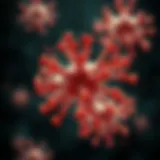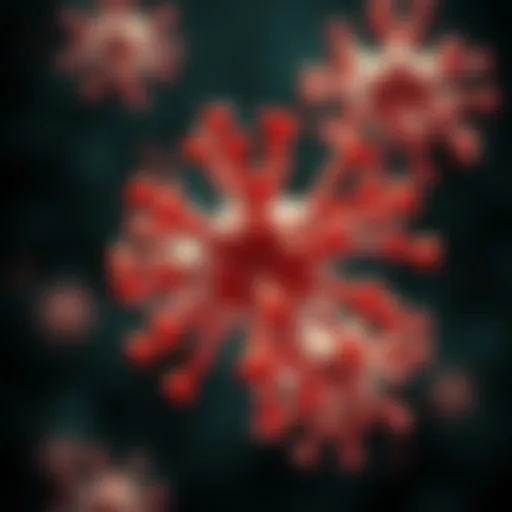Exploring the Health Benefits of Anthocyanin Foods
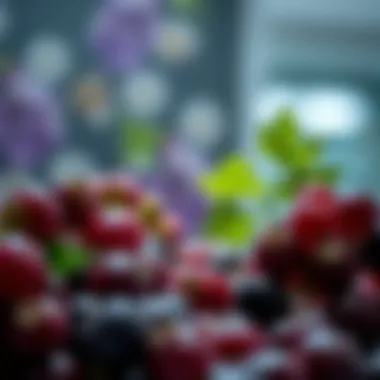

Intro
As the world becomes increasingly focused on health and diet, the conversation frequently circles around the significance of the foods we consume. Among these, anthocyanin-rich foods have begun to capture considerable attention. These colorful fruits and vegetables, ranging from deep red cherries to rich blue blueberries, not only tantalize the taste buds but are also packed with numerous health benefits. Understanding the role these pigments play in human health can be a pivotal part in addressing chronic diseases that plague modern society. This section serves as a springboard into the deeper discussions about anthocyanins—what they are, their properties, and why they matter.
Key Concepts
Definition of the Main Idea
Anthocyanins are a group of water-soluble pigments that belong to the flavonoid class of compounds. Primarily found in fruits, vegetables, and grains, these pigments provide the vibrant colors that make many foods visually appealing. Common sources include blackberries, red cabbage, and eggplants. Beyond aesthetics, these compounds are gaining recognition for their potential health benefits, which range from antioxidant properties to anti-inflammatory effects. The biochemical pathways through which they operate are complex, yet the end results are profound, influencing everything from heart health to cognitive function.
Overview of Scientific Principles
Understanding how anthocyanins work requires a brief dive into their biochemical properties. These pigments are known to interact with several biological systems in the human body. For example:
- Antioxidant Activity: Anthocyanins combat oxidative stress by neutralizing free radicals, which can cause cellular damage.
- Anti-Inflammatory Effects: Research suggests these compounds can reduce markers of inflammation in the body.
- Cardiovascular Health: By improving endothelial function and lowering blood pressure, anthocyanins may contribute to heart health.
- Cognitive Function: Emerging studies hint at a link between anthocyanin intake and improved brain performance in older adults.
These principles underscore the importance of incorporating anthocyanin-rich foods into one’s diet, particularly for those seeking to enhance their overall well-being. As we shift our focus to current research trends, it’s crucial to look at the latest findings that bolster these claims and offer insight into future studies.
Understanding Anthocyanins
In the realm of nutrition science, anthocyanins emerge as significant players in the colorful world of fruits, vegetables, and grains. They’re not merely pigments; these compounds carry a rich history of contributions to human health and well-being. The journey into understanding anthocyanins begins with their definition, traits, and myriad benefits. To grasp the full impact of anthocyanin-rich foods on our health, one must consider their definition, structure, and the vibrant hues they present in nature.
Definition and Classification
Anthocyanins are water-soluble pigments belonging to the flavonoid class, predominantly found in plants. These molecules are responsible for the deep reds, blues, and purples of an array of produce, from blueberries and blackberries to red cabbage and eggplants. They are classified under the broader category of flavonoids but are unique due to their sugar attachments and the specific chemical structure that influences their solubility and absorption in the body.
Anthocyanins are known to have more than 20 different forms, with cyanidin, delphinidin, and malvidin being some of the most studied. Each of these anthocyanins varies slightly in structure due to the presence of different sugars or molecules, affecting not just the colors they yield but also their health benefits. Understanding these variations allows researchers to delve deeper into how the specific types interact with our biology to potentially mitigate various diseases.
Biochemical Structure
The structure of anthocyanins can be a complex affair, boasting a composition primarily based on a 15-carbon skeleton, which often pairs itself with sugar moieties. The core structure is referred to as an anthocyanidin, but when sugars like glucose or rhamnose attach to it, it transforms into the anthocyanin itself. This sugar attachment is pivotal as it influences the solubility and stability of anthocyanins in various environments including our digestive system.
In essence, the molecular structure determines not just the pigment’s visual appeal but its functionality too. For instance, the presence of aromatic rings in these compounds provides antioxidant properties, while the hydroxyl and methoxyl groups play a crucial role in how effectively these pigments can neutralize free radicals. This complex interplay sheds light on why incorporating anthocyanin-rich foods into our diet holds potential for health advocacy.
Color Variation in Anthocyanins
The spectrum of colors exhibited by anthocyanins isn’t just for show. The variation in color results from pH changes, the presence of metal ions, and the specific structure of the anthocyanin itself. For instance, in acidic environments, anthocyanins often appear red, which is visible in raspberries, while in alkaline settings, they morph to a blue hue found in blueberries. This fascinating phenomenon illustrates how interlinked anthocyanins are with their environments and highlights why they can be such powerful indicators of food quality and ripeness.
The diverse colors not only attract consumers but also signify different health benefits tied to the specific types of anthocyanins present. Therefore, recognizing the colors and the culinary versatility they offer can enhance how we incorporate these foods into our dietary habits.
"The attractiveness of anthocyanin-rich foods isn’t just skin deep; beneath their vibrant façade lies a bath of biochemical benefits essential for human health."
"The attractiveness of anthocyanin-rich foods isn’t just skin deep; beneath their vibrant façade lies a bath of biochemical benefits essential for human health."
In closing, understanding anthocyanins is foundational to appreciating their role in health and nutrition. Grasping the definitions, classifications, structures, and variations of these pigments sets the stage for exploring their health benefits, absorption nuances, and practical dietary applications.
Anthocyanins in Nature
Anthocyanins, those vibrant pigments responsible for the brilliant hues of various fruits and vegetables, are far more than just eye candy. Their significance in the ecosystem extends beyond aesthetic appeal; they play crucial roles in plant biology and human health. Understanding the sources and geographical distribution of anthocyanins helps illustrate their potential benefits and underscores the importance of incorporating these colorful foods into our diets.
Sources of Anthocyanins
Anthocyanins are predominantly found in a range of foods. The pigments grant not only color but also an array of health perks that could make a substantial difference in our wellbeing.
Red Fruits
Red fruits like strawberries, raspberries, and cherries are excellent sources of anthocyanins. They are known for their vibrant color and their capability to deliver health benefits that are quite remarkable. These fruits are particularly rich in cyanidin, a type of anthocyanin linked with several beneficial effects.
One might say that red fruits are akin to nature's candy; packed with nutrients yet fairly low in calories, they make for a guilt-free treat. The antioxidant properties found in these fruits can help combat oxidative stress in the body, potentially reducing the risk of chronic diseases.
However, one must also consider the drawbacks. For instance, some people may find certain red fruits high in sugar, which could be a concern for those managing blood sugar levels.
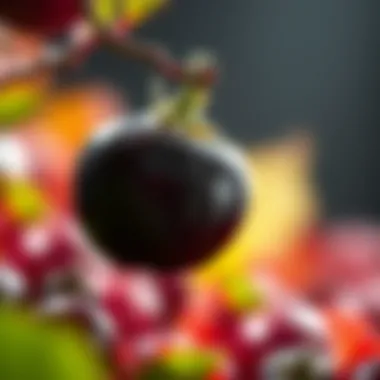

Blue and Purple Vegetables
When you delve into the realm of blue and purple vegetables, such as eggplants, purple carrots, and beets, you'll discover another bounty of anthocyanins. These vegetables are packed with delphinidin and petunidin, which contribute to their distinct colors. What's compelling about these veggies is their ability to thrive in various climates across the globe.
Apart from being rich in anthocyanins, blue and purple vegetables often come equipped with fiber and other vital nutrients that support digestive health. You could say these are the unsung heroes of the vegetable world, often passed over for their more popular counterparts. However, their unique phytochemical composition can enrich a diet and help lower inflammation and maintain heart health.
On the downside, preparation can sometimes be a limiting factor; improper cooking can lead to a loss in their vibrant color and nutritional profile, which is something to consider when preparing meals.
Whole Grains
When it comes to whole grains, you might not initially think of anthocyanins, but they play an important role here too. Grains such as black rice and purple corn are notable for their high anthocyanin content. These foods are often less processed than their white counterparts, and thus retain more of their natural goodness.
Whole grains are celebrated for providing sustained energy, making them a staple in many diets. They are beneficial not just for providing essential nutrients but also for their role in reducing heart disease risk through cholesterol lowering and blood sugar stabilization.
However, much like the other categories, the challenge lies in the preparation and selection of whole grain products. Not all whole grains are created equal; some might have lower levels of anthocyanins, depending on their variety and processing methods.
Geographical Distribution
The geographical distribution of anthocyanin-rich foods offers fascinating insights into dietary patterns around the world. From the deep apperance of black rice cultivated in Asia to the bold berries found in North American forests, the local flora rich in anthocyanins varies tremendously based on climate and soil.The cultivation and consumption of these foods can reveal not only dietary habits but also cultural attitudes towards health and nutrition.
In summary, anthocyanins are found across various elements of nature and play a critical role in both ecological systems and human health. Understanding their sources, advantages, and possible complications enhances our appreciation for these pigments and supports the notion of a colorful, balanced diet. Incorporating a variety of anthocyanin-rich foods imaginable allows individuals to tap into the myriad health benefits they offer, contributing to a more vibrant lifestyle.
Health Benefits of Anthocyanins
The significance of anthocyanins extends far beyond their vibrant colors; these pigments are key players in promoting human health. Rich in antioxidant properties, they assist in reducing oxidative stress and inflammation in the body, which can have long-lasting effects on overall well-being. As chronic diseases proliferate in the modern world, understanding the role of anthocyanins in our dietary choices becomes increasingly essential. This section will unpack the myriad health benefits associated with these compounds, exploring how anthocyanins can be a formidable ally in maintaining health and preventing a range of conditions.
Antioxidant Properties
Perhaps one of the standout attributes of anthocyanins is their potent antioxidant capability. Antioxidants work by neutralizing free radicals, unstable molecules that can damage cells and contribute to aging and chronic diseases. The unique structure of anthocyanins allows them to scavenge these free radicals effectively, helping to mitigate oxidative stress.
- Numerous studies suggest that a diet rich in anthocyanins may reduce the risk of cardiovascular diseases and certain cancers.
- Foods such as blueberries, blackberries, and red cabbage are exceptional sources of these compounds.
"Including anthocyanin-rich foods in your diet can be a simple yet impactful way to bolster your body's defenses against cellular damage."
"Including anthocyanin-rich foods in your diet can be a simple yet impactful way to bolster your body's defenses against cellular damage."
Anti-Inflammatory Effects
Inflammation is a natural process the body utilizes to heal, but chronic inflammation can lead to various health issues. Anthocyanins exhibit remarkable anti-inflammatory properties, playing a role in the regulation of inflammatory markers. By modulating the body's inflammatory responses, these pigments can assist in managing conditions like arthritis, diabetes, and heart disease.
- Research pinpoints that anthocyanins can inhibit the expression of pro-inflammatory cytokines, thus potentially alleviating symptoms of inflammatory disorders.
- Inclusion of foods such as cherries, elderberries, and purple carrots in one’s diet can support a healthy inflammatory response.
Role in Cardiovascular Health
When it comes to heart health, anthocyanins hold a promising position. Regular consumption of anthocyanin-rich foods has been correlated with lower blood pressure and improvement in overall vascular function. The pigments contribute to the elasticity and health of blood vessels, thereby reducing the risk of heart disease.
- A noteworthy study indicated that individuals with higher intakes of anthocyanins experienced a lowered risk of myocardial infarction.
- Including strawberries, black raspberries, and red grapes in your daily meals can significantly support heart health.
Impact on Cognitive Function
In the realm of brain health, anthocyanins have shown potential as cognitive enhancers. They appear to improve memory and cognitive capabilities, particularly among older adults. Some research suggests that these compounds aid in neuroprotection, helping to defend against neuro degenerative diseases.
- Regular intake of such foods may enhance overall brain function and memory retention.
- Foods like blackcurrants and blueberries can be particularly beneficial, potentially staving off the cognitive decline associated with aging.
Potential in Cancer Prevention
Lastly, the preventive potential of anthocyanins against certain cancers has garnered interest in the scientific community. Their ability to influence cell signaling pathways may help in inhibiting tumor growth and metastasis. Although findings are still emerging, notable links have been observed between anthocyanin consumption and reduced risks of various cancers, including breast and colon cancers.
- Research supports that the anti-cancer effects might stem from their antioxidant and anti-inflammatory properties.
- Incorporating foods like plums, red cabbage, and black soybeans can be considered strategic dietary choices to lower cancer risks.
In summary, anthocyanins are not just pigments that beautify our plate, but potent compounds that can bolster our health in multiple ways. By integrating a variety of anthocyanin-rich foods into our diets, we can take proactive steps toward improving our health and preventing chronic diseases.
Absorption and Metabolism of Anthocyanins
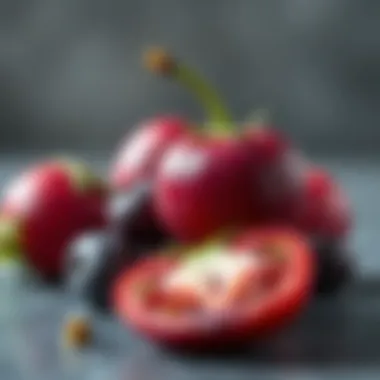

The journey of anthocyanins from our plates to our cells is a complex one. Understanding how these pigments are absorbed and metabolized in the body is crucial, as it influences their effectiveness and health benefits. How well our body can utilize these compounds determines their impact on various aspects of human health, from reducing inflammation to potentially lowering the risks of chronic diseases.
Digestive Process
When we eat anthocyanin-rich foods, the digestive process begins in the mouth, where the food is mechanically broken down by chewing. Saliva also starts the process of digestion. Once the food reaches the stomach, the acidic environment continues this breakdown, but the absorption of anthocyanins mainly happens later in the small intestine.
The walls of the small intestine, lined with villi and microvilli, have a remarkable ability to absorb nutrients efficiently. Here, anthocyanins encounter specific transporters that facilitate their entry into the bloodstream. However, it's important to note that not all anthocyanins are absorbed equally. Some may pass through the intestine without making it into our circulation, only to be processed by gut bacteria later.
Factors Affecting Bioavailability
Influence of Gut Microbiota
The gut microbiota plays a pivotal role in metabolizing anthocyanins into more bioactive forms. Our intestines host trillions of bacteria, some of which are specialized in breaking down plant compounds. These microbes may convert anthocyanins into simpler structures that the body can use more readily. This modification is a significant element as it enhances the benefits derived from these compounds.
Furthermore, the diversity of one's gut microbiome can significantly impact the absorption of anthocyanins. Individuals with a more diverse gut flora tend to experience better absorption and metabolism of these pigments. While the gut microbiota is a beneficial factor, the quality and variety of anthocyanin-rich foods consumed also affect this dynamic, showcasing the interlinked nature of our diet and gut health.
Impact of Food Matrix
The food matrix refers to the composition and structure of food and how it influences the release and absorption of nutrients. For anthocyanins, the surrounding food components, such as fibers and fats, can impact their bioavailability in multiple ways. For example, eating berries along with yogurt or nuts can enhance the release of anthocyanins due to the presence of fats and proteins that aid in digestion.
On the flip side, poorly selected combinations may hinder absorption. Cooking methods can also affect the food matrix. For instance, steaming might preserve more anthocyanins than boiling, as prolonged heat exposure can degrade these sensitive compounds.
"The benefits of anthocyanins extend beyond their vibrant colors; understanding how they are absorbed can lead to more effective dietary choices."
"The benefits of anthocyanins extend beyond their vibrant colors; understanding how they are absorbed can lead to more effective dietary choices."
In summary, both gut microbiota and the food matrix can significantly influence the absorption and metabolism of anthocyanins. By being mindful of what we consume and how we combine our foods, we can harness the full potential of these health-promoting compounds.
Cooking and Processing of Anthocyanin Foods
When delving into the impact of anthocyanin-rich foods on health, it becomes essential to look at not only what we eat, but how we prepare it. Cooking and processing significantly affect the availability and effectiveness of these pigments. As we navigate through different cooking methods and processing techniques, we shine a light on ways to retain the maximum nutritional benefits of anthocyanins.
Effects of Cooking Methods
Boiling
Boiling is a method that many folks turn to for its simplicity and speed. However, when it comes to anthocyanins, its role is a bit of a double-edged sword. On one hand, boiling can help soften tough plant fibers, making it easier for the body to digest and absorb the anthocyanins. Yet, on the flip side, it often leads to significant loss of these delicate pigments. The heat and water can leach out the anthocyanins, reducing their effectiveness.
The key characteristic of boiling is that it's quick and usually requires minimal preparation. Many people find this method particularly appealing because it is straightforward—just drop the veggies in a pot and wait. However, it’s important to note that this method might not be the top pick if you're aiming to maximize your anthocyanin intake. To mitigate nutrient loss, using the cooking water in soups or sauces can help preserve some of the pigments.
Steaming
Steaming, on the other hand, is often regarded as a healthier alternative to boiling. This method uses steam to cook food, allowing it to retain not only anthocyanins but also other essential nutrients. Since the vegetables do not come into direct contact with water, the loss of these beneficial pigments is notably less compared to boiling.
One of the standout features of steaming is that it can maintain the vibrant colors of the vegetables, which is a visual indication of nutrient preservation. Steamed food tends to retain a firmer texture and vibrant flavor, making it a popular choice among health enthusiasts. However, some people may find it less appealing since it can sometimes lead to a softer veggie that lacks the charred flavor profile offered by other methods.
Baking
Baking is yet another cooking method worth discussing, especially for its unique contributions to the flavor and texture of anthocyanin foods. This method involves cooking food in an oven, often enhancing the natural sugars in fruits and vegetables, leading to a delightful caramelization. Baking can be particularly effective for bringing out the flavors in berries, such as blueberries and blackberries, while still maintaining a good share of their anthocyanins.
The advantageous characteristic of baking is that it allows for creativity; you can experiment with various spices and add other ingredients. Moreover, because the cooking temperature can be controlled closely, there’s less risk of damaging those beneficial anthocyanins, especially when baking at lower temperatures for a moderate duration. Yet, if overcooked, some anthocyanins can still be lost, so careful timing is crucial.
Processing Techniques
Freezing
Freezing is a popular method for preserving food long-term, and it is particularly beneficial for anthocyanin-rich fruits and veggies. This process helps in maintaining the integrity of these pigments since the freezing conditions halt the breakdown of nutrients. When fruits like strawberries, raspberries, and blueberries are frozen soon after harvest, their anthocyanin content holds up remarkably well.
One appealing feature of freezing is that it provides flexibility in meal planning. You can stock up on seasonal produce and enjoy it throughout the year. However, the texture of defrosted fruits can change, becoming softer and sometimes mushy, which might not appeal to everyone for certain recipes.
Canning
Canning involves sealing food in jars and heating it to a temperature that destroys harmful organisms. While this method extends shelf life, it can also diminish the anthocyanin content significantly. The high temperatures involved in the canning process can lead to considerable pigment loss.
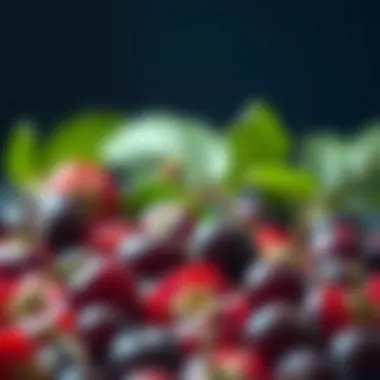

An important characteristic of canning is its convenience—it's a great way to have anthocyanin-rich foods on hand all year. However, the downside is you might be getting fewer health benefits compared to fresh or frozen options. Reading labels for added sugars and preservatives is always wise when dealing with canned products.
Juicing
Juicing is another way to incorporate anthocyanin-rich foods into one’s diet. This method extracts the liquid from fruits and vegetables, making the pigments readily available to the body. Juicing can make it easy to consume a concentrated dose of nutrients, including anthocyanins.
One unique feature of juicing is that it allows individuals to combine various fruits and veggies, thus increasing the range of nutrients consumed. Yet, it's worth noting that juicing can remove dietary fiber, which plays a critical role in digestive health. So while you’re getting a boost of anthocyanins, one should balance juice consumption with whole fruits and veggies for optimal health benefits.
Ultimately, understanding the cooking and processing of anthocyanin-rich foods can greatly influence how effectively these beneficial pigments affect health. Whether boiling, steaming, baking, freezing, canning, or juicing, knowing how each method impacts anthocyanin retention can guide choices that maximize health benefits.
Incorporating Anthocyanin Foods into Your Diet
Incorporating anthocyanin-rich foods into your diet offers a wealth of benefits that extend beyond mere flavor enhancements. These vibrant pigments not only deliver color to your meals but also act as crucial allies in the quest for better health. Anthocyanins, found predominantly in red, purple, and blue fruits and vegetables, come loaded with antioxidants which may mitigate oxidative stress and inflammation, that are now recognized as catalysts for various chronic diseases. Choosing foods high in anthocyanins can ultimately play a vital role in enhancing your overall health and wellness.
Planning Balanced Meals
When planning balanced meals, it’s essential to weave in a variety of anthocyanin-rich foods. Think of your plate as a canvas where vibrant colors represent a multitude of nutrients. For instance, lunch could feature a hearty salad topped with blackberries or a side of roasted beetroot, embracing those stunning purple hues. The idea here is to strike a balance—not just between flavors, but also between nutrients. A diverse palette of foods ensures that you harness the maximum health benefits without getting stuck in the rut of monotony.
You can incorporate these foods into every meal, making it both practical and enjoyable. Here’s an overview of how anthocyanins might fit seamlessly into your daily fare:
- Breakfast: Berry smoothies, oatmeal with blueberries, or yogurt with mixed fruits.
- Lunch: Mixed salads enriched with radicchio or purple cabbage.
- Dinner: Grilled chicken served with a side of wild rice and sautéed red onions.
Healthful Recipe Suggestions
The beauty of anthocyanin foods is their versatility—they can be crafted into myriad dishes. Here are some specific suggestions that highlight their contributions.
Smoothies and Juices
Smoothies and juices serve as an effortless way to pack in antioxidants while keeping things refreshing. Just toss some blueberries, cherries, or acai berries into a blender—these powerhouses not only lend their bold colors but also infuse your drink with a potent punch of nutrition. One unique feature of smoothies is their ability to act as a meal replacement when fortified with protein and fiber.
- Key Characteristic: Their liquid nature allows for easy consumption, beneficial for those on the go.
- Advantages: These drinks can be tailored to meet personalized dietary preferences, whether it’s a vegan smoothie or a protein-packed option. Moreover, you can combine them with greens like spinach to up the nutrient ante without compromising flavor.
- Disadvantages: If not balanced correctly, smoothies can turn into calorie bombs when overloaded with high-sugar fruits or sweeteners.
Salads
Salads are not just a side dish; they serve as a canvas for creativity and nourishment. Incorporating dark leafy greens with vibrant anthocyanin-rich items such as red cabbage or radishes adds texture and color to your meal. Not only do salads bring a crunch to your plate, but they can also be a rich source of vitamins and minerals, essential to maintaining good health.
- Key Characteristic: Their raw, fresh nature preserves the nutrients, which can sometimes be lost during cooking.
- Advantages: Salads can be diverse; you can play around with toppings, dressings, and components to suit your taste while ensuring that you’re getting a mix of nutrients.
- Disadvantages: The challenge lies in making salads satisfying. If not paired with the right toppings, some may find them less filling compared to other meals. Don’t forget to include something hearty, like quinoa or beans, to ensure fullness.
Baked Goods
When thinkin' outside the box, anthocyanins find their way into the realm of baked goods. Imagine an oatmeal cookie studded with dried blueberries or muffins made moist with mashed bananas and a blend of whole grains. The beauty of this is that you’re sneakin’ in health benefits without sacrificing flavor. While baking, anthocyanins can contribute an unexpected twist.
- Key Characteristic: These baked treats can serve dual roles—satisfying a sweet tooth while providing nutrition.
- Advantages: Baked goods can be prepped in bulk, making them an easy grab-and-go option, helping you stick to your dietary goals without much hassle. Plus, you get the bonus of enjoying freshly baked aromas wafting through your home.
- Disadvantages: Baking can sometimes denature certain nutrients, depending on the cooking time and temperature, thus it is essential to be mindful of how these foods are prepared.
Incorporating anthocyanin foods into your diet isn’t just about adding color; it’s about enriching your meals with health benefits that can impact your overall well-being. Whether it’s through a morning smoothie, a colorful salad, or a wholesome baked good, infusing anthocyanins into your diet can be both delicious and beneficial.
Finale
As we reach the endpoint of our exploration regarding anthocyanin-rich foods, it becomes clear that these pigments do more than merely decorate our plates with vibrant colors. They play a crucial role in fulfilling our nutritional needs and supporting overall health. The health benefits attributed to these compounds stretch beyond basic nourishment; they seem to wield significant potential in combating chronic diseases such as heart disease, diabetes, and even certain forms of cancer.
The studies and findings discussed throughout this article underline the importance of including a variety of anthocyanin sources in our diets. Foods like blueberries, black rice, and red cabbage not only tantalize the palate but also contribute to better health outcomes. Consuming these foods could be considered a simple yet effective strategy for enhancing well-being and longevity.
However, it’s critical to appreciate that results can vary depending on individual physiology, the way these foods are prepared, and other dietary choices. The diversity of the gut microbiome, which affects the metabolism of anthocyanins, serves as a reminder of the complexity within our bodies. Thus, it’s wise to take a holistic approach to health, focusing on balanced, nutrient-dense meals.
"Incorporating foods rich in anthocyanins is a step towards a healthier lifestyle that individuals can take today."
"Incorporating foods rich in anthocyanins is a step towards a healthier lifestyle that individuals can take today."
Ultimately, the vibrant hues of anthocyanin-rich foods not only signify their beauty but also encapsulate a wealth of health benefits waiting to be tapped into. As science continues to unravel the mysteries of these pigments, there's an ever-evolving landscape of knowledge about how our diets can be tailored for optimal health.
Future Directions in Research
The realm of anthocyanin research is burgeoning, and there are several promising pathways that warrant further exploration. One intriguing area focuses on the interaction between anthocyanins and the microbiota. Understanding how gut flora influences the absorption and metabolism of these compounds could unveil new dietary recommendations and strategies to maximize their benefits.
Another avenue worth pursuing involves the effects of food processing methods on anthocyanin stability and availability. For instance, different cooking methods might help preserve or even enhance the health benefits of these pigments. Identifying the best practices can aid in formulating guidelines for food preparation that honor the nutritional integrity of anthocyanin-rich foods.
Lastly, there’s a growing interest in the potential of anthocyanins in personalized nutrition. As research advances, it might become possible to tailor dietary recommendations based on individual profiles, optimizing anthocyanin intake for specific health conditions or genetic backgrounds. Such developments would mark a significant leap toward a more customized approach in nutrition science.
In summary, the future looks bright for anthocyanin research, and as our understanding deepens, so will our ability to harness their power for better health outcomes in society. By keeping an eye on emerging findings, we can equip ourselves with the knowledge to make informed dietary choices that include these beneficial pigments.




